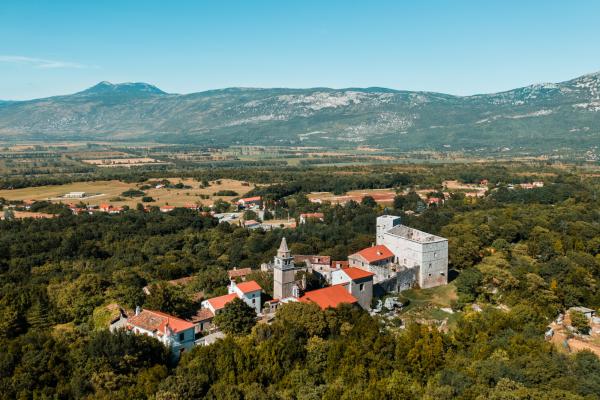KRŠAN
KRŠAN


Like this article?
Recommend it to your friends through these services..
The settlement and centre of the municipality was built next to the medieval castle, today one of the best-preserved Istrian castles, and lies along the southwestern edge of Čepić field. The newer part of the settlement is located at the crossroads of the roads to Labin, and through the Učka tunnel, to Rijeka.
Throughout its turbulent history, Kršan castle has had many rulers and lords, and therefore a rich history.
Kršan castle was first mentioned in 1274 as Castrum Carsach, which was only 40 years after the mention of Berlin, for example. Until the afore-mentioned year, it was under the administration of the patriarchs of Aquileia, and since then has been under the rule of the Principality of Pazin (the Austrian part of Istria in the Middle Ages and Human history). It is assumed that it got its current name from its 15th century owners, the Cherstlein de Pisino family, which at that time began to be called von Karscheyner. The family coat of arms features an arrowhead, and the present-day municipality of Kršan also adopted the same motif. The castle gets its name from them, Kršan, although there is another interpretation of the origin of the settlement’s name, which perhaps originates from the rugged terrain on which the Old Town is located.
During its very turbulent history, Kršan castle was managed by a number of owners. Here, for the sake of interest, it is necessary to highlight two of them. One, the feudal lord Juraj Karscheyner from Kršan, was a rich resident of the castle from the end of the 16th century, but also a notorious bandit who looted Venetian possessions under the Austrian flag. Kršan was then located in the border area between Austria and Venice, and because of his crimes, a reward of as much as 1000 ducats was secured for his head. Juraj was finally arrested and taken to Kopar, where the Venetians sentenced him to death by drowning. The last owner of Kršan castle, Baron Giuseppe Tonetti from Plomin from the beginning of the 20th century, was also an interesting figure. He was known as the "Red Baron" due to the fact that he was a leftist by conviction and openly supported the organised uprising of the Labin miners, who in 1921 were the first in Europe to rise up against the then Italian fascist repression and founded the short-lived Labin Republic. For this reason, during the Second World War, the "Red Baron" was in prison, and his Kršan castle was burned down in 1940 under very strange circumstances. An investigation showed that the fire was caused by a burning wooden beam next to the stove, and a strong bora wind contributed to the fire engulfing the interior of the building in just few moments: furniture, library, valuable paintings and family archives.
The recent start of revitalization and renovation of the castle hints that the building will become a centre of cultural events and a variety of other functions.
The patron of the municipality of Kršan is St. James, and a church dedicated to him is located in the local cemetery. During the renovation in 1991, two inscriptions in Glagolitic, the first Slavic script, were found. Thanks to its important transport position close to Rijeka, Trieste and Pazin, in the century from 1850 to 1950, Kršan had a post office, a bakery, several inns, shops, a petrol station, a mechanic's, a mill and everything else that a small town should have. Its inhabitants were also employed in the bauxite mines, in the port of Plomin and in the nearby fields. Among them were excellent sailors and port workers, as well as those who transported firewood through the port of Plomin. Kršan today is developing entrepreneurship, agriculture and animal husbandry with great success, and is also becoming a recognisable tourist destination with a number of holiday homes and interesting events such as the Wild Herb Festival, Krafifest, Kršan Wedding, Days of the Istrian Bellflower, the Hunting Festival - Hubertfest and others.
